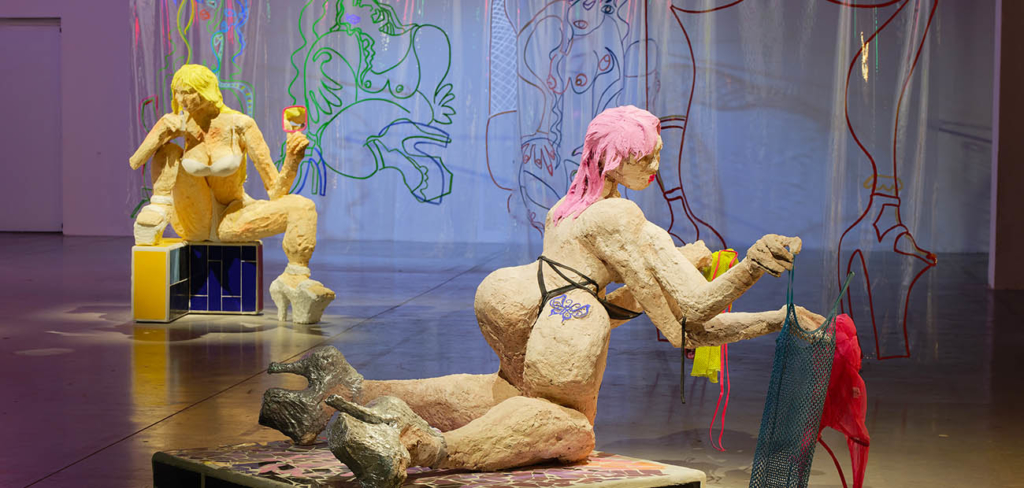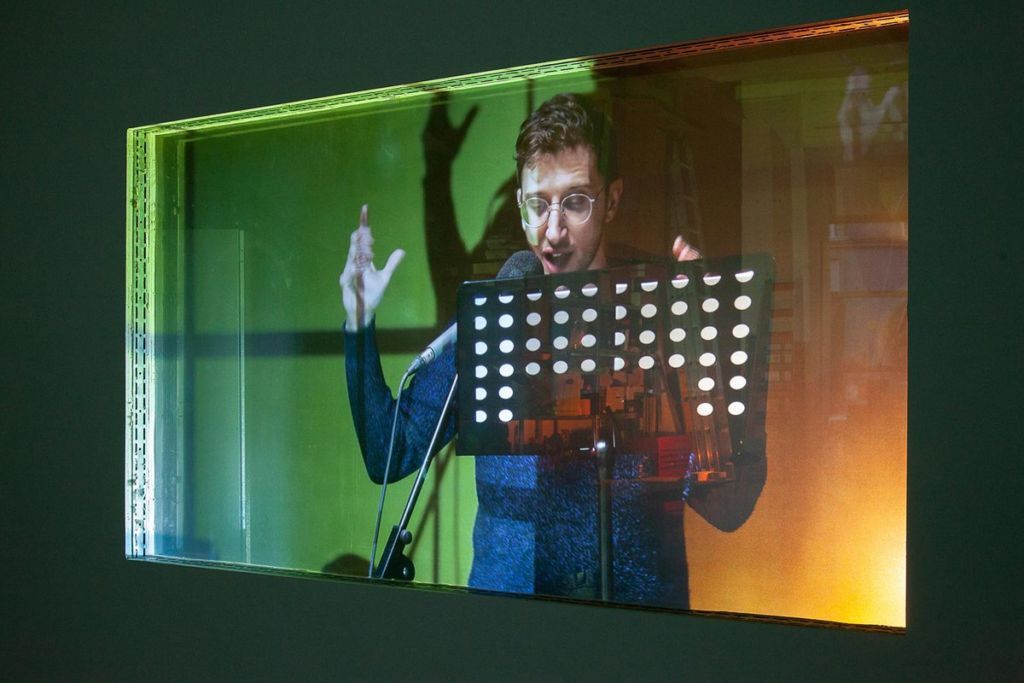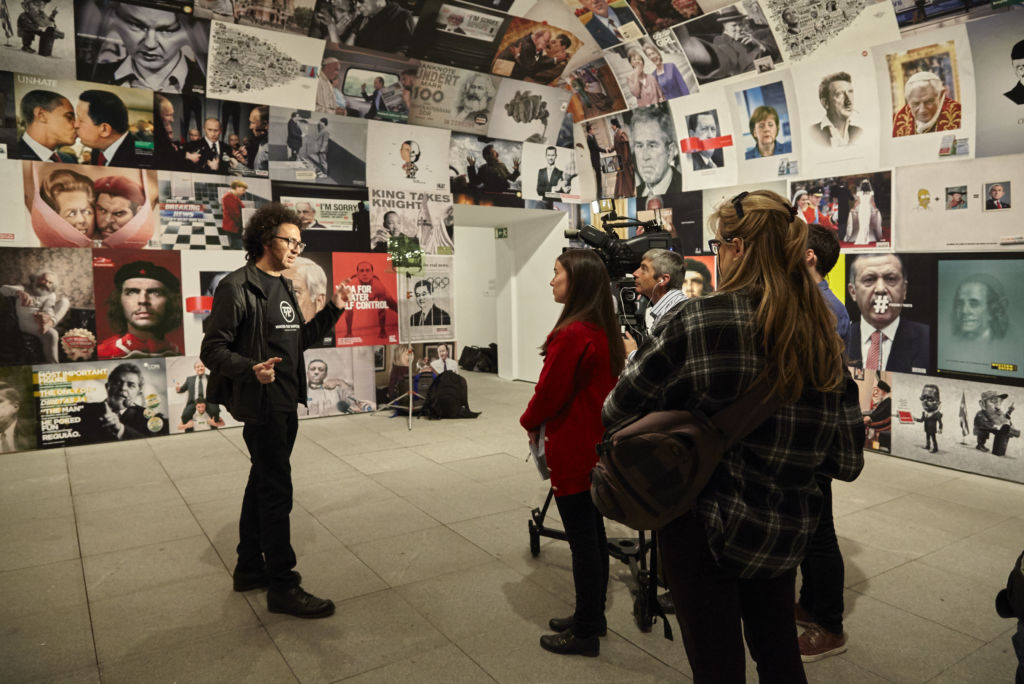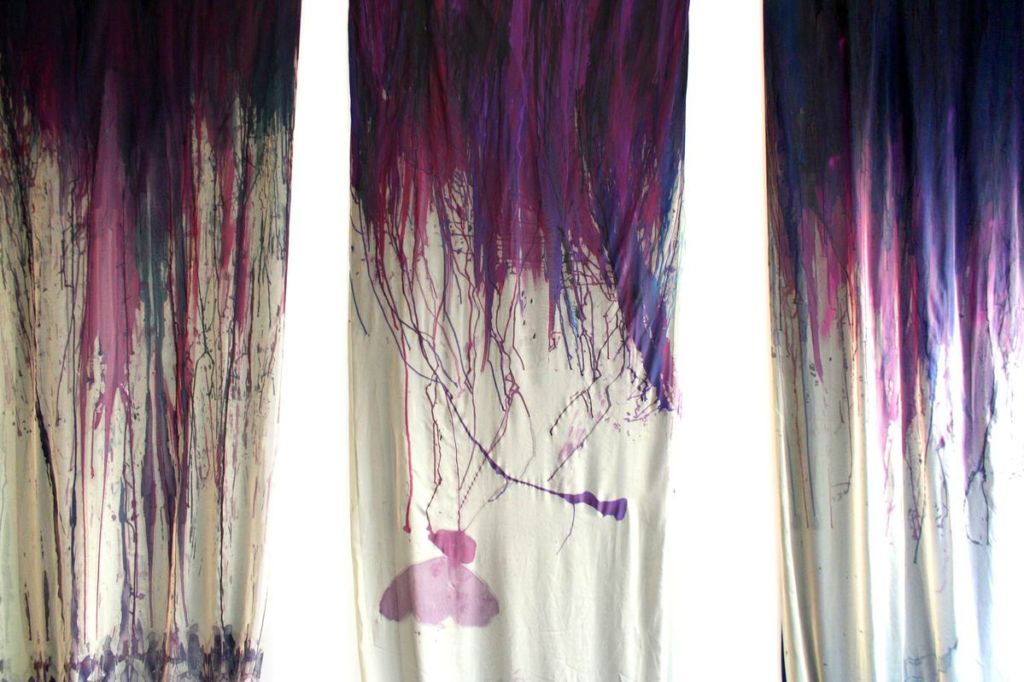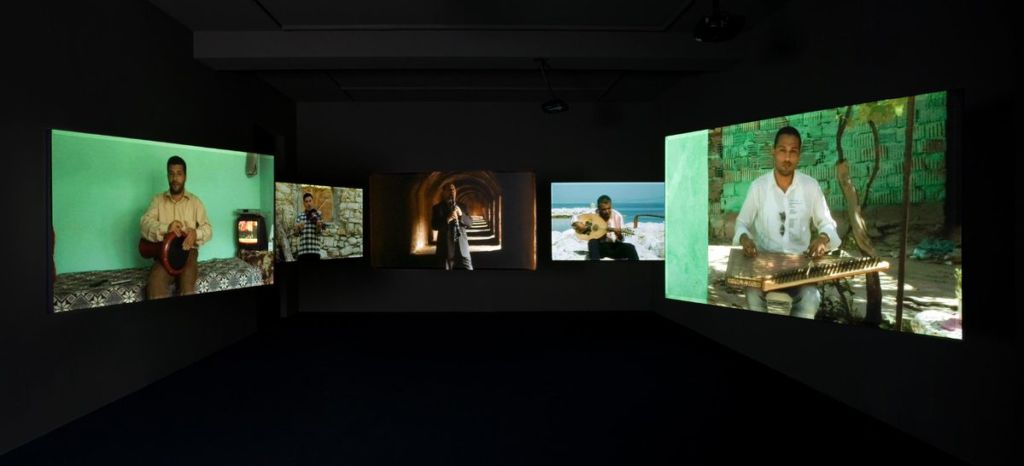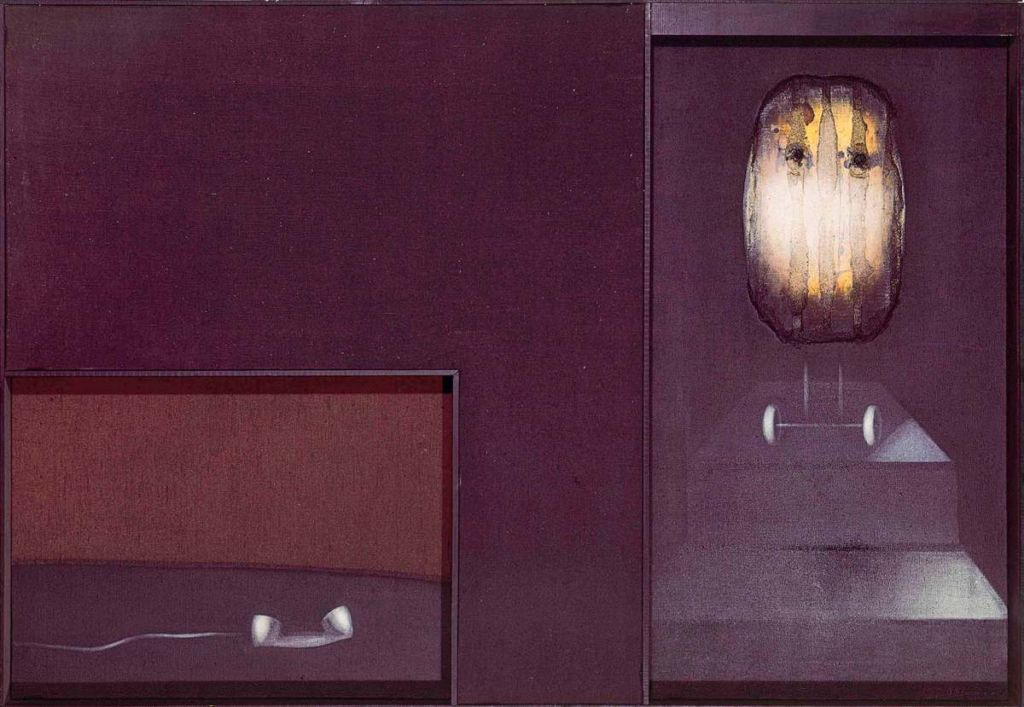Millennials Women Creators Attack the Archetypes of Femininity
Investigation by Anne-Charlotte Michaut
Garance Bonotto, Marilou Poncin, Alis Pelleschi and Chelsea Culprit are young creators who are reinvesting the archetypal figures of femininity. With humour and tenderness, they point out the contradictions in our collective representations and social behaviours. By showing the other side of the coin and diverting the stigma, they have transformed the alienating assignment to a certain type of femininity into a powerful weapon in women’s struggle for freedom, especially sexual freedom.
“La Marche pour l’égalité et contre le racisme” [March for Equality and Against Racism], referring to several marches that took place from October to December 1983, was the first national anti-racist demonstration in France, which took place in response to police violence. It was quickly dubbed the “March of the Beurs” by the media. The founding of the association SOS Racisme the following year by supporters of the Parti Socialiste was a direct result of this. The word “beur” entered the French dictionary in 1985.
Orientalism is a literary and artistic movement born in the nineteenth century, represented in particular by Eugène Delacroix who, after a voyage to Morocco, painted pictures inspired by the oriental world, accentuating the exoticism and eroticism of North African women. The theme of the harem is one of the most represented, with for example Women of Algiers in their apartment (1833). The oriental woman appears there at the disposal of male pleasure.
Simone de Beauvoir, The Second Sex, Vol. I [1949], trans. Constance Borde and Sheila Malovany Chevallier (New York: Vintage Books, 2009), 349 (epub).
The feminist concept of the “male gaze” means that women are represented in visual culture from a heterosexual male perspective. In other words, they are visually objectified for the pleasure of the male eye. The term was first used and theorised by British film critic Laura Mulvey in “Visual Pleasure and Narrative Cinema,” published in the review Screen, Vol. 16, in Autumn 1975.
The concept of “gender performativity” is defined by Judith Butler in her seminal work Gender Trouble, first published by Routledge in 1990.
These reflections have been an integral part of feminist thinking since the 1970s, when the “second feminist wave” was considered to be emerging, characterised by a struggle for a certain sexual liberation and the demand for a new place for women in the family and social spheres. In the late 1970s, the “Sex Wars” in the United States pitted the advocates of radical anti-pornography feminism against the supporters of so-called “pro-sex” feminism, considering sexual freedom and diversity as one of the goals of women’s struggle. At the turn of the 1990s, the “third wave of feminism” arrived, led in particular by ethnic, sexual or cultural minorities. This third wave, although profoundly diverse, is fundamentally intersectional, i.e., it is concerned with the interactions between different systems of oppression, including gender, race and class. To this day, tensions within feminist movements persist.
Performance on 15 May 2019, on the occasion of Garance Bonotto’s residency at the theatre Les Déchargeurs.
Marilou Poncin, interviewed by Apolline Bazin, “L’érotisme de la génération internet selon Marilou Poncin,” [The eroticism of the Internet generation according to Marilou Poncin] in Manifesto XXI, June 2019. https://manifesto-21.com/lerotisme-de-la-generation-internet-selon-marilou-poncin/
Marilou Poncin, in an e-mail exchange with the author, September 2019.
Nelly Arcan, Hysteric (2004), Trans. David Homel and Jacob Homel (Vancouver: Envil Press Publisher inc., 2014), 37 (epub).
Type “beurette” in the Google search bar. The first pages of results will almost exclusively consist of links to pornographic sites. This French term is the feminine of “beur,” itself the backward-slang of “Arab” (“a-ra-beu” becomes “beu-ra-a,” contracted to “beur”). Initially a political and media term, it was popularised in the 1980s in a context of left-wing militancy, particularly with the “March of the Beurs.”1. The term “beurette” originally referred to young women of North African origin, born in France, who managed to conform to the integration standards of French society. But a semantic shift quickly occurred and the original meaning was replaced by multiple pejorative representations, forged by the collective imagination steeped in neo-colonialism. “Beurette” gradually became a racist and sexist insult. Today, it is highly derogatory, and is one of the most popular tags used by the French to search pornography sites. Indeed, the term quickly acquired a strong sexual connotation: a beurette is a young woman trapped in a regressive family, religious and cultural straitjacket from which she needs to be extracted. This fantasmatic vision of the exotic, submissive woman of North African origin goes back to the 19th century and the orientalism of Eugène Delacroix, for example.2 A process of identity and racial essentialisation is at work, which accounts for the pornographisation of the term. The beurette is as much socially denigrated as intimately desired. For several years now, Lisa Bouteldja, a young Franco-Algerian graduate from Central Saint Martins (London) has been diverting the many clichés associated with this term on her Instagram account. She has turned the archetype into a strong mark of identity by staging herself in situations and poses that overplay the clichés ascribed to her simply because of her gender and origin. Thus, she presents herself covered in make-up, with branded clothes, fake nails, and stereotyped looks playing on veiling and unveiling, eating kebabs or smoking shisha. With a blend of humor and derision, she re-appropriates clichés, pushes them to the extreme, reverses them and thus emancipates herself from the stigmas she is a victim of.
Alienating archetypes can thus become a tool for a new way of claiming women’s freedom, a source of emancipation and empowerment. Through the art of diversion, this approach can take us to another level in our reading of the historical, societal, cultural and ideological attributions linked to femininity. Following the teachings of constructivist feminism and gender theories, femininity is understood by these creators not as a natural fact, but as a social construction, defined by specific norms, characters and behaviours, inscribed in a given social, geographical and political context. This societal injunction to femininity is a subjugation. Already in the late 1940s, Simone de Beauvoir wrote: “[a] woman knows and chooses herself not as she exists for herself but as man defines her. She thus has to be defined first as men dream of her, since her being-for-men is one of the essential factors of her concrete condition.”3 It follows that the history of representation of the female body in art is a history of the male gaze. With the advent of performance (the art of action) and the use of their own bodies as a medium in the art of the 1960s and 1970s, women artists took over the representation of the female body as it had been conveyed in traditional art, transforming it from a sexual object into a tool for emancipation. Thus, Valie Export, a pioneer of feminist art, unveiled in 1970, with the photograph BODY SIGN B, a tattoo depicting a garter and the top of a stocking on her upper left thigh. Incorporating a stereotypical accessory of the sexual fantasy associated with femininity in the male gaze,4 the artist denounced its facticity and performativity, in the sense understood by philosopher and gender theorist Judith Butler,5 according to whom gender is a social and ideological construction that defines binary normative roles, separating the masculine and the feminine. Contrary to an essentialist conception, the masculine and feminine genders are thought of here as categories of behaviour and identity that are entirely socially constructed.
The work of young female creators builds on these reflections. By reinvesting paroxysmal figures of femininity embodying a hyper-sexualisation of women’s bodies (bimbo, Girl-next-door, Lolita, femme fatale…), they combat the assignment to femininity by diverting it. These stereotype figures, the fruit of the male gaze, combine the social prejudices, condescending aesthetic judgment, and normative roles and attitudes associated with the female gender. They inspire both desire and disgust, envy and pity, fascination and repulsion, and evoke society’s contradictory relationship to femininity. To focus on these images is to underline the inconsistencies of the collective imagination and our own representations. Through sculpture, photography, theatre and video, Garance Bonotto, Marilou Poncin, Alis Pelleschi and Chelsea Culprit reveal the characteristics, the workings and, above all, the paradoxes linked to femininity as experienced in the 21st century.6 They use irony to demonstrate that femininity is an unattainable horizon, but nor can it be subject to total social deconstruction, being so historically, culturally and socially anchored, and still active. While the codes and forms they adopt are generally considered degrading for women, and condemned by feminists, they propose a reversal of the paradigm. In this sense, the creators we refer to here affirm their place and their power to act as young women, just as they pay tribute to stigmatised personalities, figures forgotten by feminism. They celebrate the struggle for women’s freedom and sexuality beyond stereotypes.
Garance Bonotto: Femininity as Masquerade
“It all started in 2001. I was nine years old and a fan of Loana [star of a French TV reality show]. Then came Pamela running along the beach in a red swimsuit, the girls from the porno magazines at the top of the newsagent’s shelves, Lolo Ferrari in the Guinness Book of Records and my bunch of lesbian Barbies.” It is with these words that Garance Bonotto, dressed all in pink, standing alone in front of the audience at the theatre Les Déchargeurs (Paris),7 starts Bimbo Estate (2018). She mixes intimate first-person narratives with fictional sketches to refer to the archetype of the bimbo based on rich preliminary documentation. The six characters who accompany her on stage are hybrid creatures inspired by real people, including La Cicciolina, Loana, Pamela Anderson or Anna Nicole Smith. Full of tenderness, sincerity and derision, Bimbo Estate is built on introspective monologues alternating with collective tableaux. The former are intimate accounts of the author’s fascination with these personalities, while the latter are staged scenes of the characters, directed or commented on by Garance Bonotto playing her own role. Deeply ambivalent, the bimbo is a figure constructed by the media society from the 1980s onwards, representing a superficial, scatter-brained, voluptuous and provocative young woman. With artifice as their trademark and means of gaining popularity, bimbos are neither feminists nor “good girls.” Far from denouncing this image, Garance Bonotto celebrates the singularities of these women and pays tribute to them. In contrast to the male gaze that has stigmatised them, she offers her female gaze on the bimbos in whom she sees personalities gifted with reason and agency beyond their media image. They are models of a new kind for an entire generation. While Pamela Anderson became famous by posing for Playboy magazine and playing a sexy paramedic in Bay Watch, she has used her fame to voice her strong commitment to animal rights and animal welfare. The ability to affect the world and the power of influence of these iconic, fantastical media creatures is unveiled and celebrated beyond their apparent passivity.
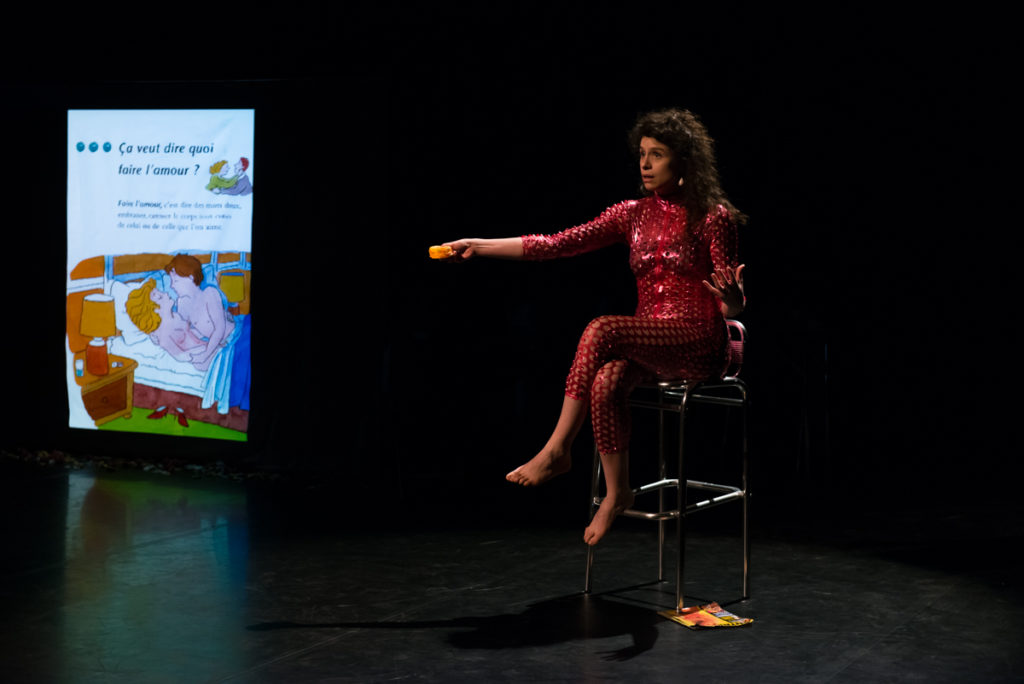
Garance Bonotto, Bimbo Estate, 2018. A show by the company 1% artistique, stage direction by Garance Bonotto. Courtesy of the artist. Photo © Arthur Crestani
The eroticised, fantasmatic environment with which these figures are associated is carefully crafted by the author, as evidenced by the profusion of attributes signifying the sexualisation of women’s bodies in the play’s scenography and sets. The stage is saturated with fuchsia pink. The set consists of a suspended screen on which, operated by the director, images from pop culture scroll past, illustrating her monologues. A white curtain placed at the back of the stage recreates the atmosphere of a peep show: the six characters use it to reveal or hide themselves. These bimbos are as singular as they are uniform in their costumes and props: the actors all wear wigs, the same cardboard mask of Marilyn Monroe and the same voluminous plastic chest. Thus, beyond the particularities of each personality, the uniformity of the bimbo stereotype appears. It comes to embody all women, but also illustrates “gender performativity.” This is evidenced in Garance Bonotto’s play by the fact that the characters are played indiscriminately by women and men. The director thus emphasises that, for both women and men, gender exists only as a masquerade.
Marilou Poncin: The Virtuality of Seduction
The creators whose works we are studying all belong to Generation Y, in other words, they are “Millennials.” While this denomination is rather vague and controversial, crystallising diverse conceptions, what the people born in the 1980s and 1990s all have in common is to be digital natives. People who have grown up with digital development and have assimilated this language as a mother tongue, as opposed to digital immigrants who experienced the arrival of digital and new technologies as an upheaval in their practices. Brought up on reality TV, teen movies or music videos on MTV, followed by the Internet, the millennials identify with new models. Singer Britney Spears perfectly embodies the television icon who has become a generational female model. Born in 1981 in the United States, she was a star on Disney Channel from the age of ten, before starting a career in pop music at the age of seventeen with the hit Baby One More Time (1998). Britney Spears’s songs have accompanied the transition from childhood to adolescence of girls born at the turn of the 1990s. The singer is portrayed as a pure, innocent yet highly sexualised child, reflecting the great cultural contradictions of the United States—a land of extremes, ultra-liberal yet highly puritanical and moralising. The products of pop culture are the repository of these contradictions, all the more so when it comes to young women. Britney Spears quickly became an icon, embodying the stereotypes of the virgin and the whore: while advocating conservative and Christian values, she came across as highly sexually liberated and outrageous. Her private life was publicised in the media, her intimacy revealed in the tabloid press, but she has remained the spokesperson for young women seeking to assert the power to act. She is socially and medially denigrated and yet held up as a model by a whole generation of young women.
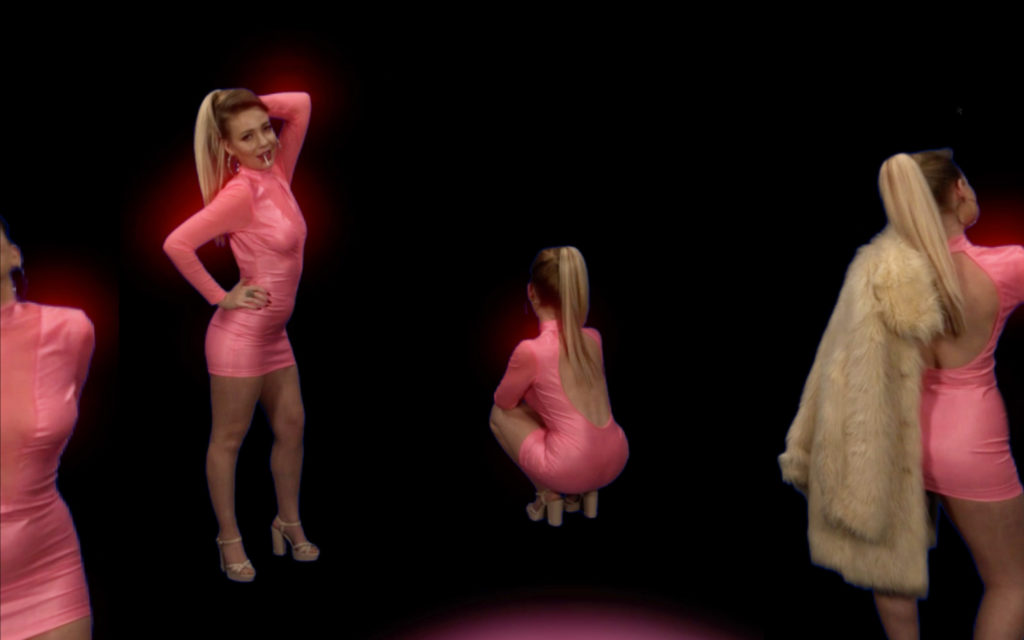
Marilou Poncin (with Camille Nicolle-Goffart), Let out the inner Bitch, 2017. VR video, 5 min. Courtesy of the artist and Galerie Laurent Godin (Paris)
Even today, young artists still use her image to reflect on the influence of the archetypes of popular culture on the construction of their own identity.
Marilou Poncin, a French multimedia artist born in 1992, has produced a work entitled Let out the inner Bitch (2017). In this virtual reality video, the artist, in the form of her digital avatar Marilove, dances lasciviously to a slow-motion version of Britney Spears’s song Work Bitch (2013), accentuating the latent eroticism of the melody. She is all dressed up, with make-up, hair tied back in a ponytail; she wears big earrings, a tight pink fuchsia mini dress and high heels. Here the video maker re-appropriates a kitsch vocabulary from popular culture, overplaying the stereotypes associated with the American singer and advocating an aesthetic of vulgarity and “bad taste.” Although Marilou Poncin says she doesn’t particularly admire Britney Spears, she recognises her importance as a figure in the construction of her generation’s identity, in that she is “a model for young girls, between bimbo and teenager.”8 Let out the inner Bitch, through the use of an avatar, also reveals the facticity of our digital identities.
The democratisation of the Internet in the 1990s facilitated the spread and expansion of pornography. The arrival, at the turn of the 2000s, of sites offering streaming content—“tube” sites—that are generally free of charge with unlimited access to content, has spurred profound changes in terms of consumption. All it takes is a few seconds on a computer or smartphone to find the video to fit one’s fantasies. Camming, which consists of “shows” filmed and streamed live on dedicated websites, promises real interactions with real people, both professional and amateur. The most common form of the practice is pornographic: camgirls engage in various erotic activities (masturbation, dance, striptease…) at the request of customers, who communicate instantly through the website.
This practice, emblematic of cyberpornography, fascinates Marilou Poncin, who has made two videos, often presented as a diptych (Cam Girl Next Door and Roxy’s Room), featuring camgirls played by two actresses. In Cam Girl Next Door (2017), a young woman recounts her experience and relationship to the practice, her thoughts on her status as a woman and her conscious subjection to male fantasies. In Roxy’s Room, the camgirl performs a private show by speaking directly at the camera, putting the viewer in the client’s shoes. The aim is to replay the mechanism of this interaction, showing its profoundly artificial dimension—women as a medium of projection. However, the work demonstrates that camming, if it is a vector of objectification for women, also proves to be a possible tool for freedom and emancipation. The generic figure of the camgirl thus becomes the spokesperson for a “generation that, although aware of the influence of the media on its femininity, cannot help but embody its codes.”9 The title of one of the videos refers to the cliché of the Girl next door, the exact opposite of the highly sexualised topoi of the femme fatale or bimbo, but whose erotic potential is no less important. This young, innocent, banal, inexperienced, even idle girl is the potential receptacle of every fantasy.
Quebec writer Nelly Arcan also evokes this archetype in her autofiction works dealing with the cult of youth, the tyranny of beauty and society’s obsession with sexuality. In Hysteric (2004), a story directly addressed to a former boyfriend and cyberpornography enthusiast, she discusses the weight of societal injunctions related to female sexuality, largely maintained by the ubiquitous mainstream pornography on the Internet. She writes: “I also got to know the masses of girls stored in your computer and who had names that indicated their category, the Schoolgirls, the College Girls and the Girls Next Door, the Wild Girlfriends and […] the Fuck Me Boots. With you, I discovered that there were very few Women on the Internet.”10 She thus evokes the desire for a young body and the way women are represented in pornography as avatars of a fantasised, standardised femininity corresponding to various codified categories—from Girl next door to MILF (Mother I’d Like to Fuck).
Alis Pelleschi: The Porosity Between Real and Virtual
Stereotypes, by influencing our representations and behaviours, are proving to be effective. With the series Super Fans (2010), Alis Pelleschi gives us a glimpse of the artificiality and constructed dimension of the models we identify with. This English photographer born in 1988 creates self-portraits in which she incarnates multiple characters inspired by icons of popular culture. She addresses the idealisation of stars, inherent to the image culture we live in, its fetishist dimension, as well as its influence on the construction of the self. In one of the photographs in the series, she portrays herself as a character named Britney: a young woman, facing the camera, poses on her knees on a bed, dressed in transparent black lingerie, a pink jacket and high stiletto boots in black patent leather, wearing a lot of gold jewellery. On the bed are books and magazines devoted to the singer, model and English reality TV personality Jordan (now Katie Price), while the walls are hung with big posters of the scantily-dressed star in lascivious poses. Here, Alis Pelleschi underlines the fact that clichés have a direct influence on building our identity through a process of identification with and fetishisation of media characters. A process that takes place in a context of the globalisation of popular culture and the generalisation of the practice of self-portraiture, particularly via selfies on social networks.

Alis Pelleschi, 3D Slut, 2011. Published in Bullett (London). Digitally reworked photograph. Clothes: Cassetteplaya. Courtesy of the artist
Like Marilou Poncin, Alis Pelleschi also deals with the digital avatars that are now easy to build online, using your own image. In her series entitled 3D Slut, she seeks to show herself as a “real-life 3D Slut.” One photograph shows her in a bikini with the word “cunt” floating above her head, like the name of a video game avatar would do. She replays this typically masculine universe, insisting on the eroticisation of the woman’s body. The photographs are digitally reworked, giving the artist the look of a virtual avatar. Composed of self-portraits, the series analyses the representation of self and identity—gender and sexual—in the digital context of the multiplication of possibilities. 3D Slut seems to assert that sexuality can now be thought of as a playground where women can emancipate themselves by consciously fulfilling the expectations of the male gaze.
Chelsea Culprit: Traditional Mediums as a Tribute to Strippers
The American artist Chelsea Culprit demonstrates through her work that clothing, accessories or finishing touches are part of the elaboration of a global and collective stereotype as well as “gender performativity.” Representing strippers through traditional mediums—paintings and sculptures—she places her work within the long history of women’s representation in art. From an image created by and for men for centuries, the body becomes in her works an assemblage of signs to be performed. Beyond the eroticised body attributes (breasts, hair, hips…) that are highlighted, a paraphernalia of props is used to signify sexualisation. The emphasis on platform shoes and lingerie in the sculptures of Transfigurations in Ritual Time (2019) is a prime example of this. The installation consists of four monumental sculptures depicting strippers in waiting poses. The strength of the representation comes not only from the excessively generous shapes of the bodies, but also from the items they are clothed with. The viewer’s attention is thus focused on the outrageous bodies, the long hair (blondes, pinks, brunettes), as well as on their accessories: a mirror with a pink surround, a lipstick, a fishnet nightdress… These objects act as normative and codified attributes participating in the caricatured representation of strippers. Chelsea Culprit’s installation is composed, in addition to the sculptures, of a large fresco, a large illuminated mirror in which a character contemplates herself, together with transparent plastic curtains on which are drawn exaggeratedly shaped female bodies. The artist is generally inspired by people around her. Thus, the figures are singularised, each with its own characteristics, but the particularities fade away and come together in a global archetype, as in Garance Bonotto’s bimbos. By depicting strippers, Chelsea Culprit pays homage to them, defying the depreciation, even demonisation, of sex work in Western society. By consciously complying with the injunctions of patriarchal society, these women regain power over their bodies, a power that has long been denied to them. Similarly, Chelsea Culprit, by adopting traditional mediums and one of the favourite subjects of modern painting, from Edgar Degas to Pablo Picasso, takes on the representation of the female body as a woman.
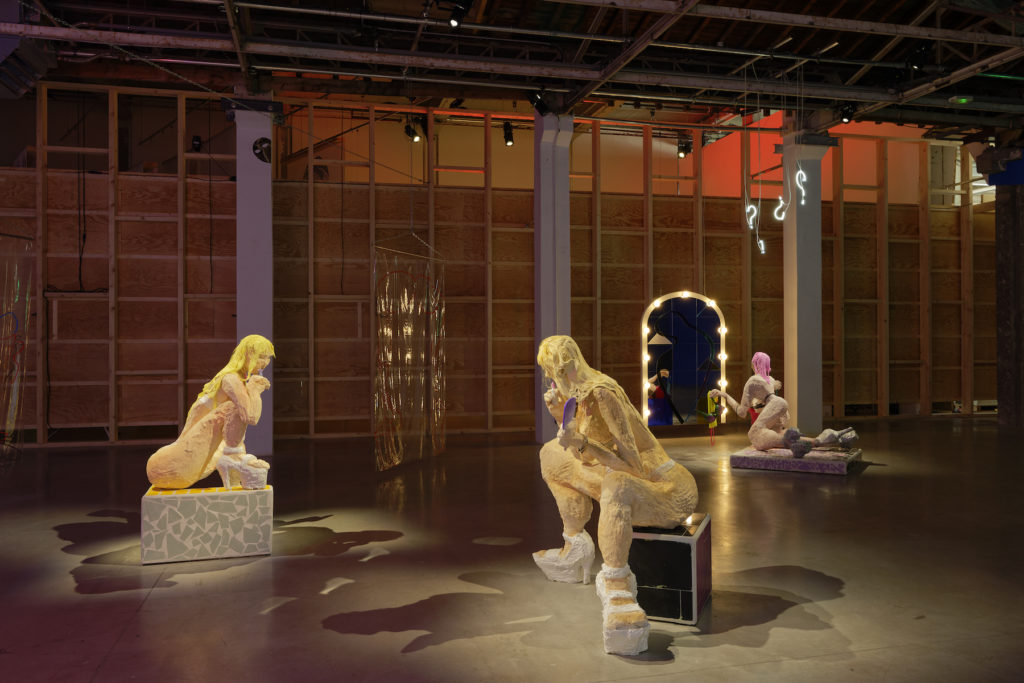
Chelsea Culprit, Transfigurations in Ritual time, 2019. Installation. View of the exhibition “City Prince/sse/s,” Palais de Tokyo, Paris, 2019. Courtesy of the artist. Photo © Aurélien Mole
The works of Garance Bonotto, Marilou Poncin, Alis Pelleschi and Chelsea Culprit offer another level of interpreting societal injunctions related to femininity. Far from raising up paroxysmal figures as heralds of feminism, these young creators give them a prime position in their works. Through the mediation of art and fiction, they celebrate their singularities, which assert themselves in the archetypes. As young women representing other women, they pay homage to a multifaceted, contemporary femininity. As paradoxical as it may seem, women’s potential for action in the world has been enhanced by the Internet and new technologies, which offer new models and a space of freedom in which women can make their bodies a tool for empowerment and a means of regaining control over their image. However, these artistic approaches still come up against a certain reticence in the world of art and theatre and even in feminist circles, which can struggle to revise their attitudes. These millennial female creators affirm and claim the right to women’s self-determination and self-representation, as essential data—if not real issues—of feminism.
Editor: Vincent Simon
Thanks to Laurence Bertrand-Dorléac
Translation by Angela Kent
Cover : Chelsea Culprit, Transfigurations in Ritual time, 2019. Installation. View of the exhibition “City Prince/sse/s,” Palais de Tokyo, Paris, 2019. Courtesy of the artist. Photo © Aurélien Mole
This text is produced with the help of Antoine de Galbert Foundation (Paris) : https://fondationantoinedegalbert.org/en/fondation/
